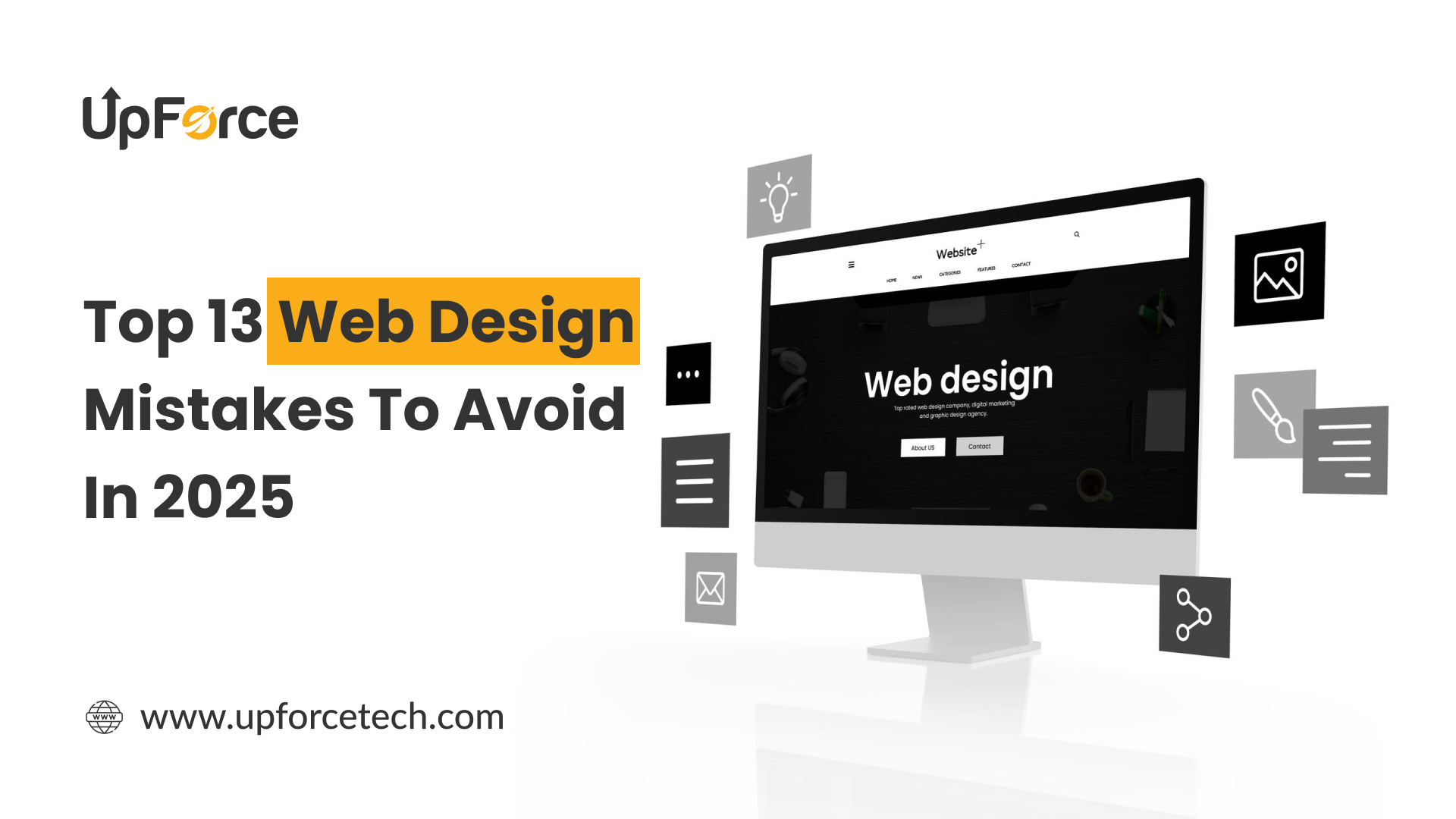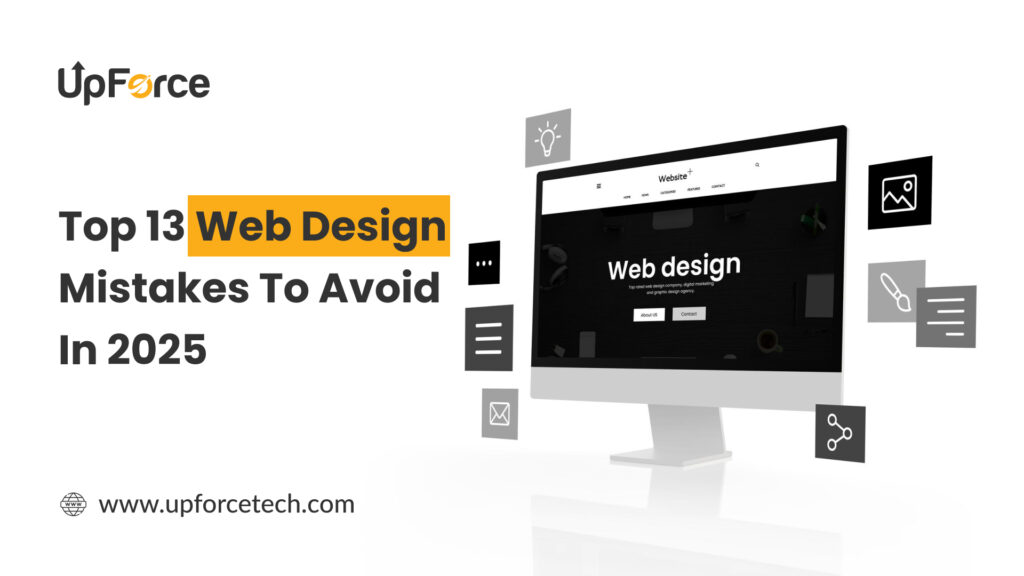Top 13 Web Design Mistakes to Avoid in 2025
Table of Contents
Top 13 Web Design Mistakes to Avoid in 2025
In the digital age, your website is your storefront, business card, and handshake all rolled into one. Imagine walking into a store with cluttered aisles, confusing signs, and outdated decor. You’d walk right out, right? Websites work the same way. A poorly designed site not only deters visitors but can also harm your brand’s reputation.
As web design trends evolve rapidly, so do the mistakes we need to avoid. In 2025, user expectations are higher than ever. Fast loading speeds, intuitive navigation, and accessible designs aren’t just preferences—they’re necessities. To help you build a website that’s modern, functional, and user-friendly, we’ve compiled the top 13 web design mistakes to avoid in 2025 and how to fix them.

1. Neglecting Mobile Responsiveness
Why It’s a Problem:
Over 58% of global web traffic comes from mobile devices. If your website isn’t mobile-friendly, you’re alienating a huge chunk of users.
Solution:
Adopt a mobile-first approach. Use responsive frameworks like Bootstrap and test your design on various devices. Tools like Google Mobile-Friendly Test can help ensure your site meets mobile standards.
2. Overloading Pages with Content
Why It’s a Problem:
Cluttered websites confuse users and lead to higher bounce rates. Less is truly more when it comes to web design.
Solution:
Embrace minimalism. Prioritize key information and use white space to create a clean, focused layout.
3. Ignoring Accessibility Standards
Why It’s a Problem:
A lack of accessibility features excludes users with disabilities, leading to a negative user experience and potential legal risks.
Solution:
- Add descriptive alt text to images.
- Use color schemes that pass accessibility tests (e.g., WebAIM Contrast Checker).
- Follow the WCAG 2.1 guidelines for accessible design.
4. Slow Loading Speeds
Why It’s a Problem:
Nearly 53% of mobile users abandon a site that takes longer than three seconds to load.
Solution:
- Compress images using tools like TinyPNG.
- Minimize CSS and JavaScript.
- Use a Content Delivery Network (CDN) for faster load times.
5. Weak Call-to-Actions (CTAs)
Why It’s a Problem:
A website without strong CTAs is like a GPS with no destination—it confuses users.
Solution:
Use action-oriented language like “Get Started Today” or “Download Now” and make CTAs visually prominent.
6. Poor Navigation
Why It’s a Problem:
Confusing menus frustrate users and make it hard to find information.
Solution:
Implement intuitive navigation with clear labels. Keep it simple—no more than seven items in the main menu.
7. Overuse of Fonts and Colors
Why It’s a Problem:
Too many fonts and colors make your website look chaotic and unprofessional.
Solution:
Stick to two complementary fonts and a color palette that aligns with your brand. Tools like Coolors can help.
8. Outdated Design Trends
Why It’s a Problem:
Design trends like skeuomorphism or heavy gradients make your website look dated.
Solution:
Focus on modern, functional trends like glassmorphism and minimalist interfaces.
9. Lack of Analytics
Why It’s a Problem:
Without analytics, you’re designing in the dark.
Solution:
Integrate tools like Google Analytics or Hotjar to track user behavior and identify areas for improvement.
10. Forgetting SEO
Why It’s a Problem:
A beautiful site that no one finds is a waste of resources.
Solution:
Optimize titles, meta descriptions, and images. Use tools like Yoast SEO to improve rankings.
11. Skipping Regular Updates
Why It’s a Problem:
Stale content reduces user engagement and credibility.
Solution:
Schedule periodic audits to refresh content and design elements.
12. Ignoring Feedback
Why It’s a Problem:
Designing without considering user input leads to irrelevant designs.
Solution:
Use surveys, reviews, and usability testing to gather insights.
13. Ignoring Page Speed Insights
Why It’s a Problem:
Page speed directly impacts user retention and search rankings.
Solution:
Use Google PageSpeed Insights to identify and fix performance issues.
Statistics
- 88% of online consumers are less likely to return to a site after a bad experience. (HubSpot)
- Websites that load in under 2 seconds have a 15% higher engagement rate.
How UpforceTech Can Help You Hire the Right Contract Developer
At UpforceTech, we specialize in connecting businesses with highly skilled contract developers who can meet their unique needs. Our rigorous vetting process ensures that you get access to the best talent, whether you need someone with expertise in front-end development, back-end systems, or mobile app development.
Here’s how UpforceTech can support your business:
- Access to a Global Talent Pool: We provide access to a diverse range of developers from around the world, ensuring you find the right fit for your specific project needs.
- Customized Hiring Solutions: Whether you’re looking for short-term contract developers or long-term project-based teams, we tailor our services to fit your requirements.
- Quality Assurance: Every developer in our network goes through a comprehensive screening process to ensure they have the necessary skills and experience to deliver high-quality work.
- Ongoing Support: Our commitment doesn’t end with hiring. We offer ongoing support to ensure a seamless integration of contract developers into your team.
For more information on how to get started with hiring contract developers, visit UpforceTech.
Are you looking to Grow your business with skilled developers? Hire a contract developer today to bring fresh ideas and expertise to your team. Learn how UpforceTech can help!
Sign up for the free Newsletter
"Web design is not just about looks; it’s about how it feels to the user."
UpforceTech
FAQs
Extremely important! Most users access websites on mobile devices, making responsiveness non-negotiable.
Google Analytics and Hotjar are great for tracking user behavior and making data-driven improvements.
Aim for a redesign or update every 2–3 years to keep up with trends.
Yes, minimalism with functional design remains a top trend.
Optimize images, minimize code, and use CDNs.
“Sign Up Now” or “Try Free for 30 Days” are action-oriented and effective.
Follow WCAG guidelines and include features like alt text, keyboard navigation, and proper color contrast.

